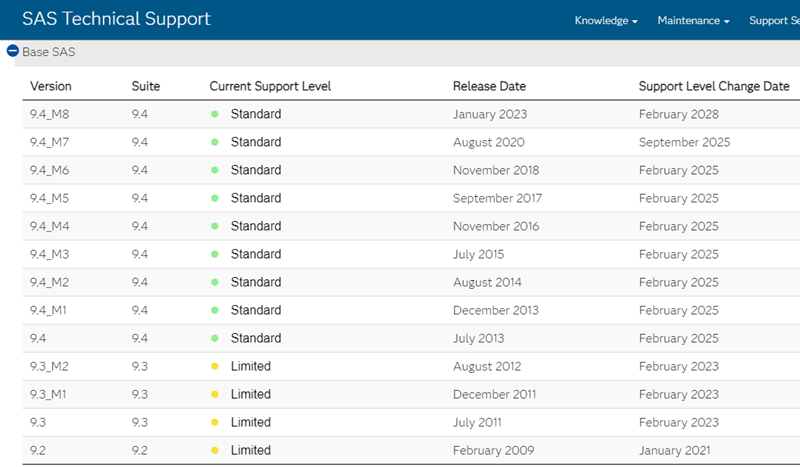I wrote a blog about Mainframe SAS in 2023, and 10 months later, I thought I should revisit the situation.
THE CURRENT SITUATION
In many ways, little has changed since my last blog.
- SAS® Institute end-of-support dates for older SAS® releases are broadly unchanged, with a very useful table here. As an example, here is the situation for BASE SAS®:

- SAS Support has updated their support page for various z/OS versions here (if you get a page not found, search for “SAS note 9193”). There is a nice summary of the current situation.
“All releases of SAS at Level A support will run successfully on all current IBM mainframe hardware and operating system releases. When new z/OS systems or operating system software goes GA (General Availability) SAS will support them, although it might not support all new features. Any necessary fixes for specific hardware or software are noted below. Most older releases of SAS also run successfully on current IBM machines and operating system releases, but they are not tested, and the support level guidelines apply. SAS recommends upgrading to the latest release and applying the most current maintenance and hot fixes for that release.”
- Some customers are now encountering the issue raised in SAS Support Note 69871
Problem Note 69871: MXG code cannot read TYPE 70/72 records that are longer than 32K records due to a change that IBM made.
This is exacerbated by the latest IBM® z hardware and z/OS releases, causing SMF/RMF data to increase in size. However, it does appear that some customers have reported similar issues against normal, none MXG, applications with records greater than 32K – in at least one case, this was against a legacy application where the records being processed have just grown over 32K.
NB: The SAS Hotfix for this issue is currently only available for 9.4M7 and 9.4M8 (March 2024).
Taken together, I believe this makes it even more important to make good use of the remaining time (11 months at the time of writing this) to make sure that by February 2025 you are running your SAS Language application in a fully supported environment.
ANOTHER OPTION TO CONSIDER
In November 2023, I was invited to join Altair on their stand at the excellent annual GSE UK Conference at Whittlebury Hall. This gave me an opportunity to see the Altair SAS Language Compiler in action as well as see how their associated tooling works to minimise migration effort. It was very interesting being on the stand as the Altair messaging resonated with many attendees.
If you have not looked at the Altair SAS Language Compiler recently, I recommend that you spend time looking at this product as it is functionally rich, installation on z/OS can be done in less than two hours, and it is a very cost-effective solution for running existing applications written in the SAS Language.
To help rapid adoption, Altair supplies some really useful sets of tooling to help review and migrate applications:
- A static analysis tool called Analytics Workbench reviews your applications to ensure syntax compatibility. This is a very easy-to-run tool that can give you confidence that your application will run in the Altair SLC environment.
- A monitoring toolkit that you install in your z/OS environment to capture the ACTUAL usage of your application workflows. This enables you to determine which components are actually used – a recent example had a customer discover an entire application was running daily generating exactly zero output records!
This toolkit creates a GANTT chart, allowing you to visualise your workflow(s) – this is extremely useful when planning the sequence of application migration to the SLC environment.
On the technical level, these tools can reassure you that your legacy applications can be easily migrated and help you formulate a plan of action.
CONCLUSION
I believe all of my suggestions from last year are still very relevant. In addition, I’d also recommend that z/OS sites with applications written in the SAS Language take a look at Altair SAS Language Compiler – I think you, and your, purchasing department, might be pleasantly surprised.
If you are interested in discussing any aspect of your SAS Mainframe usage and are looking to get some more “ideas” then please get in touch with us.
Talking to us could be the catalyst you need to drive positive change to your mainframe environment and ensure your system remains fully supportable beyond February 2025.
INTERESTED IN LEARNING MORE?
Book a Free 30-Minute Consultation
Your business' data has potential and it can reach new heights with a Free 30-Minute Consultation from Analytium! Book a meeting with our expert, Sander De Hoogh, and get personalised insights into optimising your data strategies.
Thank you for considering Analytium. We look forward to helping you achieve your data-driven goals. Click below to schedule your consultation and start transforming your data.
During The Call, You Can Expect:
- A brief analysis of your current data challenges
- Recommendations tailored to your business needs
- An overview of how Analytium’s solutions can drive your success

March 27, 2024



